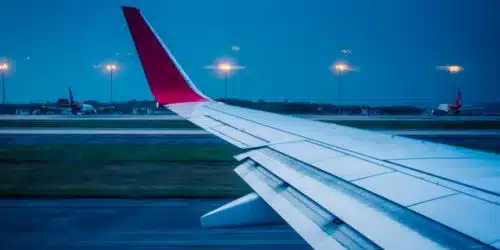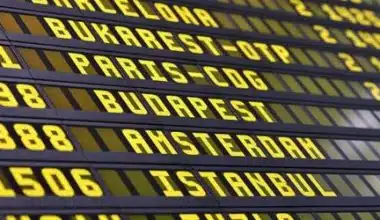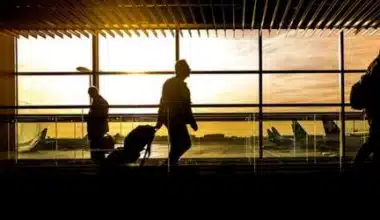We frequently seek flexibility, cost reductions, or even last-minute experiences when it comes to flight travel. Enter standby flights, a one-of-a-kind option that allows travelers to fly on a “standby” basis without a confirmed seat reservation. In this blog post, we’ll delve into the world of standby flights, learning what the tickets are, how to get them, and the chances of getting on one. So buckle up as we go on an interesting voyage through the intricacies of standby flights.
What is a Standby Flight?
Have you ever been in a scenario where you needed to travel quickly or were seeking a more flexible way to fly? This is where standby flights come in. A standby flight is when you travel without a confirmed seat reservation on a specific flight. You must instead rely on the availability of open seats on the flight you want to take. Standby travelers are effectively “on standby,” waiting to see whether any seats remain once all confirmed passengers have checked in.
How Does Standby Travel Work?
Standby travel works by filling empty seats on a plane. Airlines frequently overbook flights to account for anticipated no-shows or cancellations. After all confirmed passengers have checked in, the airline evaluates the number of available seats and decides whether to accept standby customers. If there are open seats, standby passengers are allowed to board the flight on a first-come, first-served basis, or according to the airline’s unique priority rules.
Reasons for Flying Standby
People choose standby flights for a variety of reasons. One common motive is adaptability. Standby travel lets you be flexible, accommodating last-minute plans or unexpected changes in your itinerary. Standby flights can be an appealing choice if you have a flexible schedule and can change your travel plans on short notice. Furthermore, standby travel is sometimes less expensive. Airlines may offer lower flights or special standby rates to fill empty seats, allowing travelers to save money.
The Pros and Cons of Standby Flights
Standby flights, like any other kind of transportation, have pros and cons. Let’s explore the pros and cons of choosing to fly standby.
Pros of Standby Flights
- Flexibility: Standby travel allows you to adjust your plans at the last minute or take advantage of unforeseen opportunities. Standby flights can present intriguing opportunities if you’re willing to change your vacation dates or destinations.
- Potential Cost Savings: Standby travel is generally less expensive, especially if your trip dates and times are flexible. Airlines may offer discounted flights or special standby rates, allowing you to book a seat at a cheaper price than usual.
- Opportunity for Upgrades: Standby passengers may occasionally be eligible for an upgrade to a better class of service. If suitable seats in business or first class are available, airlines may offer these seats to standby passengers for a fee or as a goodwill gesture.
Cons of Standby Flights
- Uncertainty: The major drawback of flying standby is the uncertainty of whether you’ll be able to board the desired flight. Because you don’t have a confirmed seat, there’s always the possibility that the flight will be full or that other standby passengers will be given higher priority, preventing you from boarding.
- Lack of Control: When traveling on standby, you give up some control over your trip arrangements. You must be prepared to miss your desired flight or to wait for many flights until a seat becomes available. This lack of control can be stressful, especially if you have deadlines or connecting flights.
- Limited Flight Options: Standby travel may limit your flight options because you are dependent on flights with available seats. This could include taking alternate routes, longer layovers, or departing at less convenient times to maximize your chances of finding an available seat. It is critical to consider whether the possible benefits outweigh the constraints in terms of your travel requirements.
What are the Chances of Getting on a Standby Flight?
Airlines’ policies, flight availability, and your priority level all affect your chances of being able to board a standby flight. Here are some important things that can influence your chances:
#1. Airline Policies and Procedures:
Each airline has its own set of standby regulations and procedures. Some airlines may prioritize standby passengers depending on characteristics such as frequent flyer status, ticket type, or sequence of requests. To understand your chances, educate yourself on the precise rules and guidelines of the airline you’re flying with.
#2. Seat Availability and Flight Load:
The quantity of available seats on a flight is an important consideration in influencing your chances of being placed on standby. When a flight is fully booked with confirmed passengers, the chances of getting a seat as a standby passenger are reduced. However, if a flight has a low passenger load or a high number of no-shows, your chances may rise. It is critical to remember that popular routes and busy travel periods are often more difficult for standby travel.
#3. Travel Time:
The time of day or the day of the week can have an impact on your chances of boarding a standby flight. Flights during peak travel periods, such as early mornings, evenings, or weekends, are typically busy and have fewer available seats. Selecting less popular travel periods or weekdays may improve your chances of finding available tickets.
#4. Standby Priority Status:
Airlines frequently establish priority levels for standby customers. Customers with greater priority, such as elite frequent fliers or airline staff, have a better chance of getting a seat than customers with lower priority. If you are not a priority group member, your chances may be reduced, especially if several standby passengers are fighting for limited seats.
#5. Flight Connections and Multiple Options:
Having various flight alternatives increases your chances of being able to board a standby flight. You boost your chances of finding an available seat if you are flexible and can examine alternate flights or connecting routes. Having access to multiple airports or locations within a specific radius can further expand your possibilities.
#6. Season and Location:
Standby travel can be more difficult during peak seasons or to major tourist locations. Flights to popular vacation spots or during peak travel periods are frequently in great demand. When determining your chances of getting on a standby flight, consider the season and destination.
It’s vital to note that standby seat availability varies substantially depending on the flight and conditions. While some standby travelers may be able to board their intended flights, others may be rejected many times or have to wait for several flights before finding an available spot. It is critical to have backup strategies in place in case your standby efforts fail.
How to Get a Standby Flight
Now that you’re ready to try your luck with standby flights, let’s look at how you may improve your chances of getting a seat.
#1. Planning and Research
It is critical to conduct research and plan ahead of time before going on your standby journey. Begin by identifying airlines that provide standby services and learning about their policies and processes. Some airlines have specific standby programs, but others may provide standby on an individual basis.
#2. Contact the Airline
Once you’ve determined which airlines provide standby service, contact their customer care or bookings department. Inquire about their standby policies, procedures, and any costs or regulations that may apply. The airline employees can give you detailed information and walk you through the entire process.
#3. Dress Appropriately
Believe it or not, your clothing can occasionally make a difference in securing a standby seat. If there are only a few seats available, dressing properly and professionally may help you make a good impression and increase your chances of being chosen.
Standby Flight Tickets
Understanding the ticketing process is critical when it comes to standby flights. Let’s look at how standby flight tickets work and what you should know about them.
Types of Standby Tickets
Employee standby tickets and passenger standby tickets are the two main types of standby tickets. Employee standby tickets are typically issued to airline employees and eligible dependents. In contrast, passenger standby tickets are available to the general public and are subject to specific terms and conditions.
Booking a Standby Ticket
You must visit the airline’s ticket counter to request a standby ticket. Standby tickets are usually issued on the day of travel and are limited in number. It’s important to note that standby tickets aren’t guaranteed, and you might have to wait until closer to the departure time to find out if you’ve gotten a seat.
Standby Policies and Fees
Every airline has its own set of standby policies and fees. It is critical to become acquainted with these guidelines to avoid surprises or misunderstandings. Let’s take a closer look at some of the most common policies and fees associated with standby travel.
#1. Standby Priority
Airlines frequently implement a priority system to determine which people receive priority for standby seats. Elite status, fare class, and ticket type (such as full fare versus discounted rate) are a few examples of the variables that may affect your priority level. It’s critical to understand how the priority system for the airline you’re flying with works.
#2. Standby Fees
Some airlines charge for standby travel. These fees can vary depending on the airline, aircraft, and ticket type. Standby fees may apply whether or not you secure a seat, so it’s critical to inquire about any applicable fees before opting for standby travel.
Standby Alternatives and Strategies
If the uncertainty and potential difficulties of standby travel do not appeal to you, you have other options and strategies to consider. Let’s look at some standby flight alternatives and strategies for increasing your chances of getting a confirmed seat.
#1. Flexible Fare Options
Many airlines provide flexible fare options, allowing you to change your travel plans without incurring significant fees. These fares frequently offer more flexibility than standby travel while still allowing you to change your itinerary if necessary.
#2. Last-Minute Deals
Rather than relying on standby travel, you can look for last-minute flight deals. Airlines and travel websites may offer discounted fares for unsold sea close to the departure dates. By keeping an eye on these deals, you might be able to find a more cost-effective alternative to standby travel.
#3. Off-Peak Travel
Traveling during off-peak hours increases your chances of finding available seats. Flights on weekdays, early mornings, or late evenings typically have fewer passengers, giving you a better chance of obtaining a confirmed seat.
#4. Booking Connecting Flights
If you can’t find a direct flight with open seats, consider taking a connecting flight. By segmenting your itinerary, you may have more options and a better chance of acquiring a seat on one of the connecting flights.
Do you usually get on a standby flight?
Although no standby seat is guaranteed (hence the name “standby”), there are some things you can do to improve your chances. You must first request standby as soon as possible, as airlines typically prioritize standby passengers on a first-come, first-served basis.
Is it cheaper to fly on standby?
Flying standby can be less expensive than booking a regular, confirmed ticket, but this is not always the case. However, it’s important to note that standby travel is not always cheaper. In some cases, regular ticket prices may be lower, especially if you book well in advance or during promotional periods. Furthermore, if you have specific travel dates and needs, the limited availability of standby seats may result in higher prices for the remaining seats.
What happens when airlines put you on standby?
When airlines put you on standby, it means that you don’t have a confirmed seat reservation on a particular flight, and you will need to wait for seat availability to determine if you can board the flight. Here’s what typically happens when you are on standby:
- Check-In and Documentation
- Waiting for Seat Availability
- Seat Allocation
- Boarding Process
- Waiting for Alternate Flights
Who gets to fly standby?
Standby travel is available to certain groups of passengers, but eligibility and priority can vary depending on the airline and specific circumstances. Here are some common categories of passengers who may have the opportunity to fly on standby:
- Airline Employees
- Family Members of Airline Employees
- Frequent Flyers
- Military Personnel
- Airline Partners and Alliances
- Certain Ticket Types
How much is a standby ticket?
How much a standby ticket costs varies from flight to flight and airline to airline. Most airlines charge a $75 same-day change fee in addition to standby fees ranging from $25 to $100.
Conclusion
Standby flights are an appealing option for flexible travelers looking for adventure or cost savings. While they come with risks, recognizing the factors that determine your chances of acquiring a seat and executing the proper methods can enhance your standby travel experience. Whether you’re a spontaneous explorer or a budget-conscious tourist, standby flights can offer up a world of possibilities. So, next time you’re set to board a flight, remember the pleasure and adventure of standby travel.
- WHAT HAPPENS IF YOU MISS YOUR FLIGHT | Best Actions To Take
- ECONOMY CLASS: Flights and Features
- PREMIUM ECONOMY AMERICAN AIRLINES: All You Need To Know
- FIRST-TIME FLYING TIPS: 15 Best Tips
- HOW EARLY CAN YOU CHECK FOR A FLIGHT? All You Need To Know






